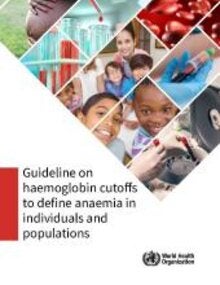This guideline aims to help Member States and their partners in their efforts to make informed decisions on the appropriate tools to support assessing and reducing the global burden of anaemia as an important public health priority. The WHO Global nutrition targets 2025 include a 50% reduction in the prevalence of anaemia in women of reproductive age. The 2030 Sustainable Development Goals (SDGs), in particular, Goal 2: End hunger, achieve food security and improved nutrition and promote sustainable agriculture and Goal 3: Ensure healthy lives and promote well-being for all at all ages, encompass alleviation of anaemia. This guideline will also support Member States in their efforts to achieve the global targets of the Comprehensive implementation plan on maternal, infant and young child nutrition and the Global strategy for women’s, children’s and adolescents’ health (2016–2030).
Appropriate guidelines for measuring haemoglobin and defining anaemia are crucial for both clinical and public health medicine but require consideration of a range of complexities across different populations.
The normative statements in this guideline are intended for a wide audience, including policy-makers, their expert advisers, and technical and programme staff at ministries and organizations involved in the design, implementation, and scaling-up of actions for addressing anaemia. Other end-users of the guideline include nongovernmental and other organizations and professional societies involved in the planning and management of anaemia actions, as well as health professionals including clinicians, managers of nutrition and health programmes, national blood services, and public health policy-makers in all settings.
The objective of this guideline is to provide updated, locally adaptable, clear, evidence-informed normative statements on the use of haemoglobin concentrations to assess anaemia and on best approaches in its measurement in individuals and populations. The purpose of the guideline is to improve the diagnosis of anaemia, grounded in gender, equity and human rights approaches, with the aim of leaving no one behind, thereby informing the development of nutrition and health policies
|

